Breeds and breeding
Breeds
Domesticated chickens originate from the red jungle-fowl (formerly known as the Bankiva or Bankiva fowl) and some other wild species in Southeast Asia. From there, domesticated animals were brought to the entire world by tradesmen and sailors. Over time, domestication and breeding resulted in many distinct breeds that vary in colour, size and other traits such as performance.
Hybrids
In high-producing intensive systems, but also on many specialised organic farms, hybrid chickens are commonly used. Most hybrids are specialised either in egg production or for meat production.
While hybrid layer hens lay up to 330 eggs per year, their roosters are not good for meat production, as they gain weight very slowly and thus need much feed and time to reach slaughter weight. So far, the common practice was (or still is) to kill the male chicks of hybrid laying breeds right after hatch. In some countries, they are sold to small-scale producers at a low cost.
On the other side, broiler hybrids have a very high weight gain, but aren’t suitable for egg production. They grow so fast that they have difficulty walking and surviving until reproduction. In the last years, dual-purpose hybrids have been bred by some breeding companies. The hens of these hybrid chickens lay slightly less and sometimes smaller eggs, while the roosters grow a bit slower, but are still very good for meat production.
All hybrids have in common that their feed ration needs to be properly formulated to fulfil their special needs, and management needs to be very good so that they reach their production potential.
Most hybrids are bred in cages (not allowed in organic farming). Their husbandry in environments of organic farms and in regions with climates other than temperate conditions may be challenging. Nevertheless, some breeding companies offer parent stocks to produce dual-purpose chickens for a variety of climatic conditions as found on the African continent.
Hybrid chickens are bred from four different highly selected grandparent lines. They have been selected for maximum performance. A few large companies developed the hybrids and own the grandparent stock. If a farmer breeds with hybrids, the offspring will not have the same performance as the parents. Therefore, new hybrid chicks have to be bought for each batch.
Pure breeds
In traditional and extensive production, the use of pure and indigenous breeds is common. Many of them are dual purpose breeds, which means that the hens are used for egg production and the roosters, as well as old hens, for meat production. Indigenous breeds are often well-adapted to local conditions and are therefore more robust. In some countries, they are also highly preferred by consumers for their taste. Despite these advantages, many larger producers do not use pure breeds because they do not perform at the same level as a well-bred crossbreeds or hybrids.
In pure breeds, hens and roosters are of the same breed. Therefore, they can be used for breeding on the farm. The offspring will have similar traits as the parents. Performance of the breeds can be increased by selecting the hens and roosters with the best performance on a farm for reproduction. Over time, this will allow the breeding of chickens that are adapted to the specific circumstances and needs of a farm.
Pure (indigenous) breeds are suitable if farmers are looking for robust animals. However, these breeds will never lay as many eggs as a layer hybrid or grow as fast as a broiler hybrid. One reason for this is that the energy and nutrients the chickens have available can be invested either in maximising egg production, or in maximising muscle growth, or a little of both. Maximum performance in egg production and muscle growth at the same time is biologically impossible. Another reason for this is that hybrids use the so-called heterosis effect: when crossbreeding two genetically different strains, the offspring can show better performance than the parent lines.
Cross-breeding
A good option to increase performance in chickens is the use of cross-breeds. For breeding cross-breeds, two different pure breeds are taken. The advantages compared to hybrids are that the pure breeds are not owned by companies, and that one can select breeds as parent stock that suit specific needs and are well-adapted to the local conditions. Similar to hybrids, offspring of cross-breeds often shows better performance than the parent breeds.
Important traits for organic chickens are, for example, a good tolerance to changing feed quality and good suitability for the outdoor run. Furthermore, the breeds should perform well under the prevailing climatic conditions.
For cross-breeding pure breeds, both pure breed lines must be available for breeding of each batch. Generally, a flock of the mother line is reared, whereas the father line is brought in with changing roosters from other breeders.
When cross-breeding, one must know that good performance of the offspring is not guaranteed. For good results, parent stocks need to be chosen with consideration, and performance of the offspring must be documented in order to find suitable combinations for specific needs. Furthermore, breeding efforts are also required for the parent breeds, if one wants to further increase the performance of a preferred cross-breed.
Successful selection requires many chickens and generations. Therefore, it is advisable to join forces with other chicken farmers or – if available – to buy chicks from professional breeders in the region.
Another option for farmers is to start with a well-adapted and well-performing indigenous breed and cross-breed it with changing well-performing dual-purpose breeds, meaning by using roosters from different breeds every one or two years. This increases the chance of better offspring performance (increased heterosis). However, there is no guarantee that performance always benefits from such experimental breedings. It can also be challenging to regularly find new suitable breeds locally for cross-breeding.
Dual-purpose breeds
With the increasing importance of high-performing hybrids for egg and meat production worldwide, attention to the performance of traditional breeds has decreased. Most traditional breeds have been kept for preservation of the breed, and selection focused more on appearance than performance. Nevertheless, there are still many traditional dual-purpose breeds with promising features for breeding, and breeders who have been selecting these breeds for good production performance.
Considerations
When choosing a breed, a cross-breed or a hybrid, the suitability of the breed for the environment it is expected to live in needs to be considered. Many hybrids are selected for good performance in cages and with trimmed beaks. Their use in alternative systems such as semi-intensive organic production can be challenging. Traditional breeds that thrive in Nordic climates may do less well in warmer conditions, and those coping well in dry areas might have problems in more humid environments.
Sharing of knowledge on chicken breeds
Encourage sharing of experiences and discussion in groups on chicken breeds by asking the following questions:
- What are your experiences with chicken breeds/cross-breeds/hybrids? What are their advantages and disadvantages?
- Are these chickens suitable for the climatic and husbandry conditions on your farm?
- Do you know any hatchery, breeder, farmer or other person who keeps this breed in your region? Do you know, how successful they are with respect to animal health, viability and production?
- Which additional information do you need to choose animals for breeding? Where can you get this information? What are trustworthy sources?
Breeding
For breeding, whether it is for pure breeds or cross-breeds, a number of criteria need to be considered, observed and monitored, and the individuals for breeding must be selected carefully to further improve the breed towards the expected characteristics and performances. For the selection of hens, individuals with a good body weight and a good laying performance must be selected. Selection criteria for the rooster can be weight gain, feed conversion, body weight, vigilance and behaviour towards humans and hens. All breeding chickens must be fit and healthy. For indicators for healthy chicken see chapter 5.3.1.
Of course, eggs for breeding need to be from groups of chicken with roosters for insemination of the eggs. The date of lay must be noted on the breeding eggs with a pencil to be able to estimate the hatching date. Additionally, information about the parent stock can be written on the egg, if one wants to know from which hen an egg is. Fertile eggs can be incubated either by broody hens or in an incubator. The chicks hatch in general after about 3 weeks. Hatching rates can differ largely depending on the breed, fertility, temperature, humidity and duration between lay and incubation. For eggs shipped from somewhere else, the hatching rate can be as low as 50 %. When breeding is done on a farm, one should aim for a hatching rate of at least 80 %. If the hatching rate is below 80 %, the number of roosters may be insufficient or the conditions during incubation are not ideal.
Brooding with hens
For many generations, the hens of many breeds have been selected for high egg laying performance. Their broodiness is reduced, as broody hens naturally stop laying eggs when the clutch is complete. If one wants the fertilised eggs to be incubated by hens, he/she has to find hens that become broody. Some breeds are known to be good brooders and chick mothers. One very well-known breed is the silky chicken. Silky chickens are often used solely for this purpose, as their laying performance is rather low and the eggs are quite small. Of the African breeds, the South-African Potchefstroom Koekoek is said to be sufficiently broody, and is at the same time used for egg and meat production. But one can also find broody hens in other dual-purpose breeds. One can identify them easily by looking for the following signs.
A broody hen ...
- Leaves the nest only shortly to feed and drink,
- Stops roosting on perches during the night to stay in the nest,
- Stops laying eggs,
- Protects the nest by squawking, growling, puffing up her feathers or pecking,
- Pulls out her chest feathers.
Hens don’t have to show all signs when they become broody, but these signs give a good hint. The most important one is that the hen stays in the nest during the night. Hens rarely become broody in winter, when days are very short. If one wants to encourage hens to become broody, spring or beginning of summer is the best time to do so. The farmer should provide the hens with sufficient warm, dark and secluded nests with food and water nearby. Putting several dummy eggs into the nest will further encourage brooding. Dummy eggs can be made of wood, clay, or even plastic eggs or smooth stones can be used.
When the hens are visibly broody, the dummy eggs can be replaced by fertilised eggs during the night or while the hen is feeding.
Feed and water should be served in close proximity to the brooding nests, so hens don’t starve while brooding. It is advisable to separate the broody hens from the other chickens. This will ensure that they are not disturbed, and it prevents other hens from adding eggs during the brooding period. If too many eggs are added by other hens, it may become difficult for the brooding hen to keep the eggs warm with the result that the eggs do not hatch. Or some eggs may be ready for hatching while others are not, and the hen would then leave the nest with the chicks and abandon the other eggs with the unhatched chicks. If the brooding hens cannot be separated from the remaining chickens, the fertilised eggs can be marked with a pencil and additional eggs can be removed daily.
Outside the brooding period, the broody hens are usually kept separately from the layers, as the broody hens stop laying eggs as soon as their clutch is complete. Furthermore, they are more reluctant to feed, drink and dust bathe. Last but not least, broody hens can trigger other hens to become broody as well.
One broody hen can brood 10 to 12 or 15 eggs per batch, depending on her size and the eggs’ size. For a batch of 50 new layers for egg production and 50 roosters for meat production, about 12 broody hens are needed who raise about 100 chicks or more, depending on the hatching rate and chick survival.
Raising chicks from artificial incubation
Artificial incubation is common in middle and large-scale brooding. Usually, brooding of large numbers of chicks is not done on the farms producing the eggs and the meat, but on specialised brooding farms. These farms have parent stock to produce the fertilised eggs, and have the equipment to incubate the eggs until hatching. Artificial brooding requires incubators that provide optimal temperature and humidity to ensure high hatching rates. The brooding farms deliver day old chicks either directly to farms for meat production or to farms specialised in raising chicks for a few weeks, who then sell the young hens and roosters to the production farms.
Buying pre-raised chickens can be a good option if they are available in the region, as the husbandry of the chicks in the first few weeks is challenging. In this phase, chicks need a lot of attention, professional care and good feed. Additionally, during this time vaccinations must be carried out (see chapter 5.4). When buying young stock, farmers must make sure that the chicks have received the necessary vaccinations, look healthy, and are well developed. The body weight should correspond to the expected body weight of the specific chicken strain at that age.
If farmers want to raise their own chicks or buy day-old chicks without having mothering hens, they must make sure to fulfil the main cornerstones of successful chick rearing as described below. Additional and more detailed information may be necessary to ensure proper rearing with minimal losses and well-developed animals.
Cornerstones of successful chick rearing:
- Hygiene: The stable must be thoroughly cleaned and disinfected before new chicks arrive. If the stable has been used for poultry before, an empty period of at least two weeks is necessary to reduce the risk of transmission of pathogens. The litter must be dry and clean at all times. Wet litter has a very negative impact on chick health and must be removed and replaced by fresh dry litter immediately.
- Care: The chicks must be checked several times a day. All chicks must look healthy and have access feed and water. All chicks must have access to all resources at all times. The distribution of the chicks with regard to the heat source must be observed, and the filling of the crop must be checked. In case of inhomogeneous growth, even the smallest chick must be able to still reach the feeders and drinkers.
- Ventilation: The stable must receive fresh air without draught and without too much temperature fluctuation.
- Temperature: The temperature should be around 34 °C in the first few days, and then decrease slowly. The best way to provide the right temperature is to let the chicks choose the place with the appropriate temperature, and to observe their behaviour. The chicks need to have the possibility to move away from the heat source if it is too warm, but it should never be too far so that they cannot find their way back. Chicks need to find water and feed in close proximity of the heat source to stay warm at all times.
- Water: Clean and sufficient water is extremely important. Chicks need approximately 2 to 6 times the amount of water compared to feed. The higher the temperature, the higher their need of water. The water must be so clean that it could be served to humans without hesitation.
- Feeding: See chapter 4
- Vaccination: See chapter 5.4
- Setup: The stable must be dry, even in the rainy season (see chapter 3 for more details). Feeders and drinkers must be adjusted to chick size. The space for day old chicks should be round or corners need to be rounded, e. g. with cardboard, to prevent piling and smothering. Small perches should be offered from the beginning to train chicks to use them.
- Documentation: Chicks can be weighed on a regular basis to compare the weight to breeder recommendations for the respective strain at the age. Weights within a flock should be as homogenous as possible.
- Preparation: The stable must be prepared in advance with enough time for cleaning, repairs and disinfection. At least one day before chicks are delivered, all resources should be installed and filled and the stable needs to be heated.
Exercise on production systems, feeding and breeds
Prepare four different examples of farms. These farms can be imaginary or real farms and are described to the participants in detail: farm size, crops cultivated on the farm, location, climate and weather conditions, available manpower, level of mechanisation, soil type, animals on the farm.
Ask the participants to discuss the following questions in groups:
- Which poultry production system would you recommend to use?
- How can the chickens be fed?
- Which breeds would best go to the farm?
Then, every group should present their ideas and thoughts. After every presentation, give some additional clarification or recommendations, if necessary
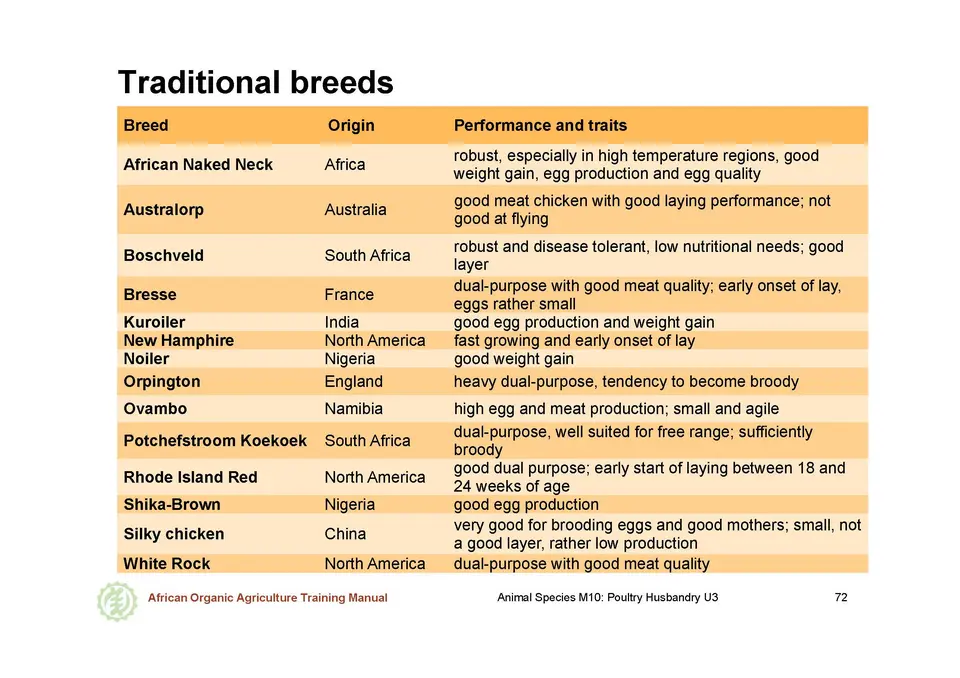
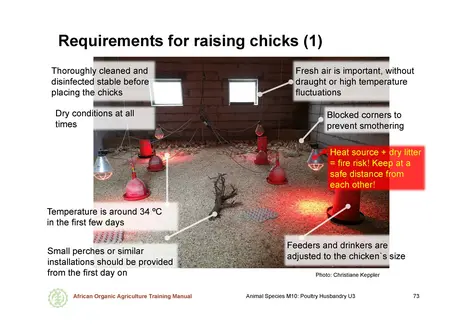
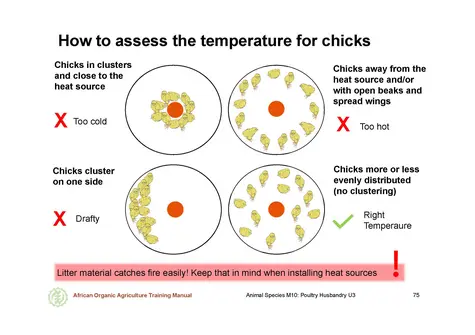
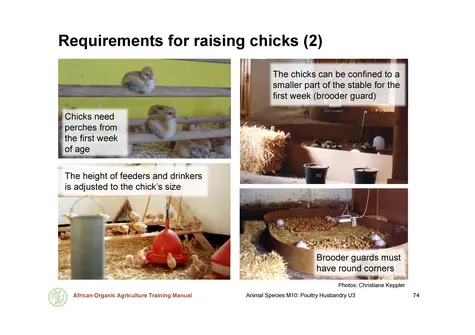
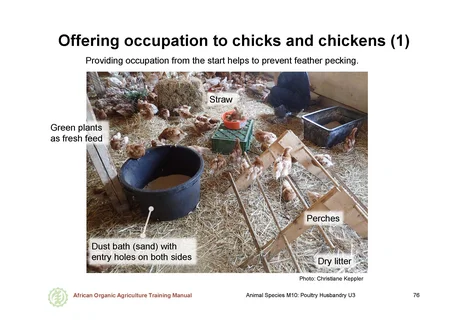
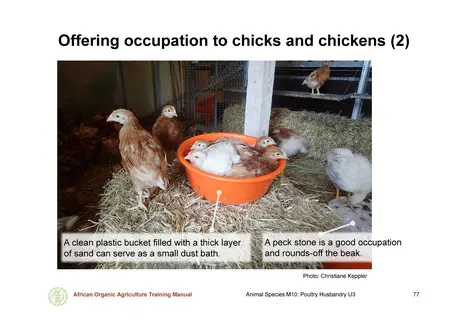
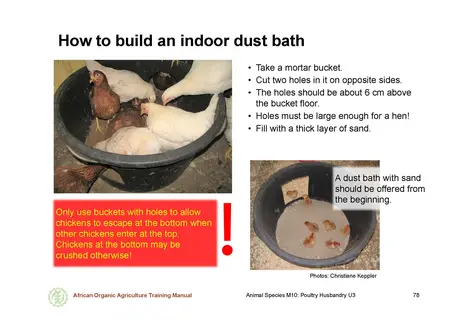
 tap and then scroll down to the Add to Home Screen command.
tap and then scroll down to the Add to Home Screen command.